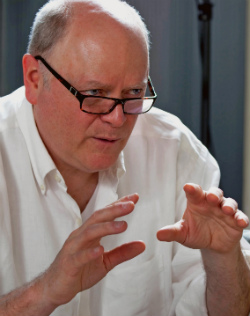Igniting Innovation!

Creative thinking and innovation are the engines that drive business growth. The value and differentiation that come from these two elements can be downright game-changing.
To that end, Digital Marketing NOW had the pleasure of interviewing Gregg Fraley, a powerhouse in the innovation world. Gregg is the founder of KILN, which provides fresh approaches to innovation. Gregg’s background includes everything from founding and managing software companies to working as an interactive television producer. He’s the author of the first ever business fable about creative problem solving, “Jack’s Notebook,” and he’s a thought leader in corporate innovation. Gregg has been quoted in many publications, including Successful Meetings, Skyline News, Redbook, Crain’s Chicago Business, The Chicago Tribune, Chicago’s Daily Herald, Forbes, and US News and World Report.
The following is our interview with Gregg, offering you guidance for sparking greater innovation at your company:
Please tell us about KILN.
KILN ignites creativity in companies. We help organizations get to breakthrough innovation concepts by helping them make meaning of current cultural trends. To do this we offer both traditional consulting, creative problem solving (CPS) training, and coaching services and also a unique stimulus product for the front end of innovation — called IdeaKeg. We bring cutting edge expertise in the innovation process, including idea generation, commercial storytelling, and concept development.
What are a few keys to creating a culture of innovation within a company?
There are many keys which is one reason it’s so difficult. Keys would include: management support of innovation initiatives, a faster spinning FEI cycle, a flexible and consistently used process, using idea management systems properly, strategic use of cultural and marketing insights, and…a sense of fun and urgency.
What are typical missteps that companies make when striving to be more innovative?
Not getting any training is a mistake — particularly for those companies that haven’t been active. Thinking trend decks or focus groups is enough to give you awareness of culture change and weak signals is another barrier.
Not doing a bit of work on innovation all the time is another big mis-step. We often see a big effort, but only once a year.
Another classic issue is simply not tracking ideas and concepts. That’s an area that’s so easy to solve. It’s also counter-productive to have a big session or initiative and then not letting people participating know what happened (this communicates a message that innovation isn’t that important).
Not getting in front of management with pitches often enough. Management not taking enough risk. Not getting any outside expertise in terms of content (no “open innovation”) or facilitation of process. Any innovation effort should address the Four P’s of People, Process, Products, and Press (environment). The most important P is Press — if you get the culture right you can stumble your way to success; if you get it wrong, all the people and process and product in the world won’t save you.
What’s one technique that people could use today to start being more creative and innovative in their work?
Keeping an idea notebook, that is, writing ideas, questions, and observations down. Doing this rigorously can have a dramatic positive impact on creative effectiveness. Mash up what you notice with the problem you’re trying to solve. This is called Mashup Thinking and it really works.
What’s the key to effective brainstorming?
There are many keys, but if you had to pin me down to one I would say make sure you have a compelling ideation question to answer. See, an idea answers or responds to a question. That question is called a problem frame or an ideation platform. A brainstorming session is focused (or not) by this question. A question that is too generic or open ended will get you a lot of ideas, but they will tend to be useless. If the question is highly focused you may have a small number of ideas, but they’ll tend to be germane.
Other keys would include: professional facilitation, stretching out the time of ideation to include a pre and post session online, using kinaesthetic and/or visual stimulation tools, and getting a few brilliant outsiders in to help. Training your people in a flexible method like Osborn-Parnes Creative Problem Solving also helps. Osborn, after all, coined the term “brainstorm” back in the 1940s.
Tell us about IdeaKeg.
KILN offers a unique subscription service called IdeaKeg, which is a stimulus tool for the front end of innovation. In each IdeaKeg customers find 7 carefully curated trend-objects (usually commercial products that represent a trend). The objects we choose are great starting points for bringing fresh cultural data into the front-end of the innovation process. IdeaKeg comes with a robust process and guide for facilitating meetings that have organizations forming braver, bolder questions — that can then be answered with breakthrough ideas. The process is multi-modal (visual, auditory, kinesthetic, and verbal). IdeaKeg activates your people’s many sensory modes with a flexible DIY process. In short, it scaffolds new thinking. The mash-up of the objects with a companies challenge often results in that elusive breakthrough thinking. IdeaKeg is available in several formats, from a ‘single’ box to an 8-times-a-year subscription. IdeaKeg is used by internal innovation teams and is also used by professional ideation facilitators.
 Eager for more?
Eager for more?
Join Gregg and Digital Marketing NOW’s own Tom Shapiro at 10:45am on October 18th at FutureM in Boston, where they will be co-hosting the session “Hot Digital Marketing Trends 2014 vs. 2024.” The session will explore the hottest marketing trends coming your way, as well as methods for turning such trends into innovation for your business.
Use code DIGMKTGDISC for 10% OFF your all-access pass to the three-day FutureM event!

